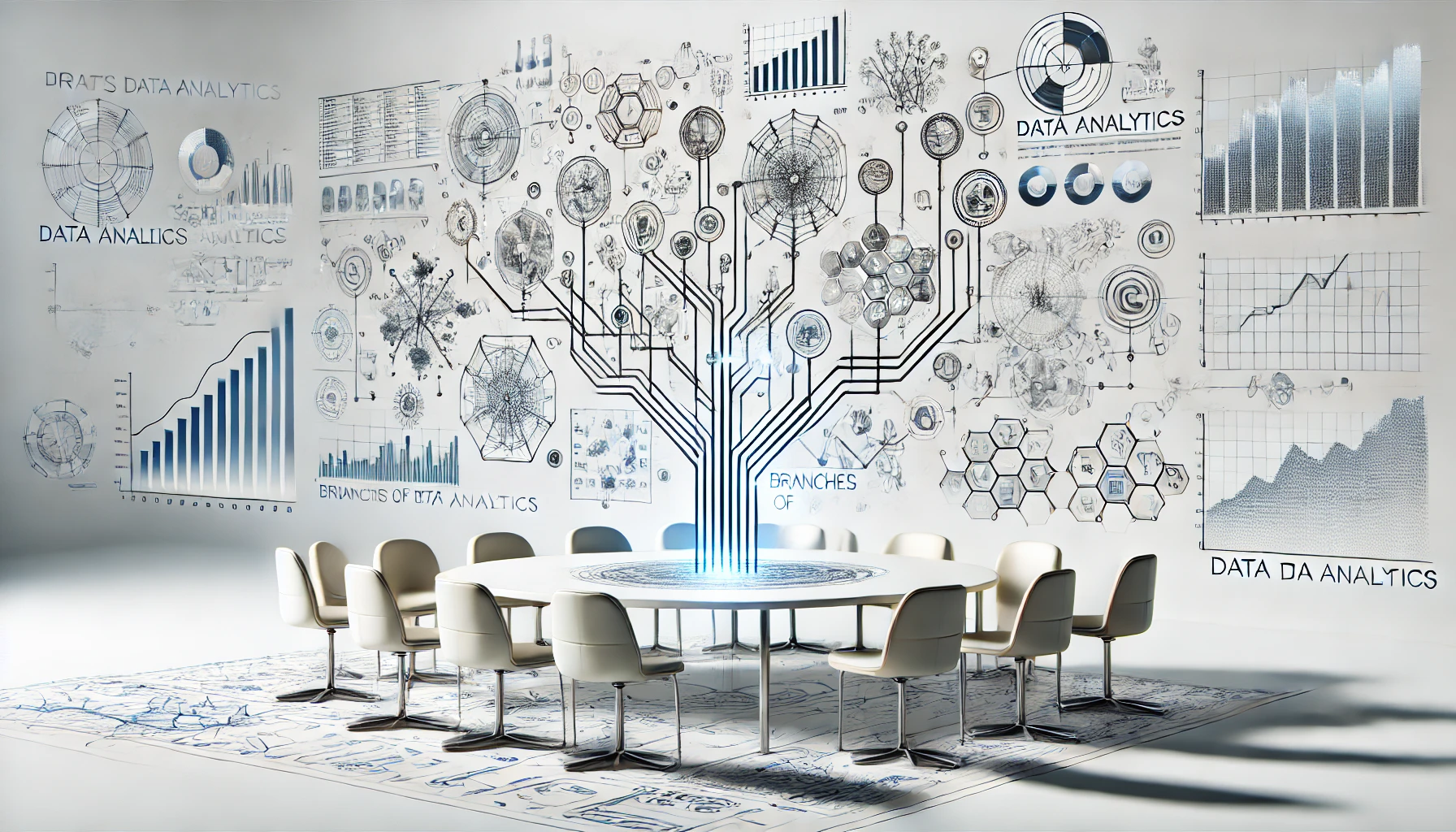You may have heard about data analytics, but did you know there are ten key branches of data analytics that hold immense significance in the realm of data-driven decision-making? Each branch offers unique insights and strategic advantages that can revolutionize how businesses operate in today’s data-centric world. From predictive analytics to business analytics, each branch plays a crucial role in uncovering hidden patterns and trends that drive success. Understanding these branches is not just beneficial but essential for anyone looking to harness the power of data effectively.
Predictive Analytics
Utilizing historical data and statistical algorithms, Predictive Analytics aims to forecast future trends and outcomes based on patterns identified in the data. By employing machine learning algorithms, predictive analytics can analyze vast amounts of data to make predictions about future events. These algorithms learn from historical data to identify trends and patterns that can then be used to predict future outcomes with a certain level of confidence.
Data visualization techniques play a crucial role in predictive analytics by providing a clear and concise way to present insights derived from the data. These techniques help in understanding complex relationships within the data, making it easier to interpret and communicate the results of predictive models. Visualizing data also aids in identifying outliers, trends, and patterns that might not be apparent when looking at raw data.
Data Mining
Data Mining involves various data extraction techniques, pattern recognition methods, and predictive modeling applications. By employing these techniques, you can uncover hidden patterns and relationships within large datasets. This process enables you to make informed decisions and predictions based on the analyzed data.
Data Extraction Techniques
Employing advanced algorithms and statistical models, data extraction techniques, commonly known as data mining, enable organizations to uncover valuable patterns and insights from vast amounts of data. Data extraction best practices involve identifying the data sources, understanding the data structure, and selecting appropriate data extraction tools. It is crucial to clean and preprocess the data before applying extraction techniques to ensure accurate results.
Data extraction tools such as SQL, Apache Hadoop, and Python libraries like Pandas and NumPy are commonly used to extract, transform, and load data for analysis. These tools offer functionalities for filtering, aggregating, and merging datasets efficiently. Moreover, they facilitate the process of extracting data from various sources such as databases, websites, and APIs.
Pattern Recognition Methods
To progress from data extraction techniques to the realm of pattern recognition methods, organizations tap into the power of data mining to uncover intricate patterns and relationships within their datasets. Pattern recognition methods encompass various techniques such as image recognition applications, which utilize deep learning algorithms to analyze and identify patterns within images. These algorithms allow machines to recognize objects, faces, or even gestures in images, enabling automation in various industries.
Additionally, pattern recognition methods involve anomaly detection methods, which are crucial for identifying outliers or irregularities in datasets. By employing unsupervised learning techniques, organizations can detect anomalies that may indicate potential fraud, errors, or abnormalities within their data.
Predictive Modeling Applications
Utilizing predictive modeling applications through data mining techniques enables organizations to forecast future trends and outcomes based on historical data analysis. By leveraging machine learning algorithms, businesses can extract valuable insights and make informed decisions. Time series analysis plays a crucial role in predictive modeling, allowing companies to predict future values based on past data patterns.
- Machine Learning Algorithms: Implementing various algorithms such as Random Forest, Gradient Boosting, or Neural Networks enhances predictive modeling accuracy.
- Data Preprocessing: Cleaning and transforming data before applying predictive modeling techniques is essential for achieving reliable results.
- Model Evaluation: Utilizing metrics like accuracy, precision, recall, and F1 score helps in assessing the performance of predictive models.
- Feature Selection: Identifying and selecting the most relevant variables for predictive modeling improves the model’s efficiency and interpretability.
Big Data Analytics
Big Data Analytics plays a pivotal role in extracting valuable insights from massive datasets to drive strategic decision-making. To make sense of enormous volumes of data, effective data cleaning processes are essential to ensure accuracy and reliability. Utilizing data visualization techniques enhances the interpretation of complex information, aiding in identifying patterns and trends. Machine learning algorithms and statistical analysis methods are commonly employed in Big Data Analytics to uncover correlations and predict outcomes. Machine learning algorithms like neural networks and decision trees can handle vast datasets efficiently, while statistical analysis methods such as regression analysis provide valuable insights into relationships within the data. By harnessing these tools, organizations can gain a competitive edge by making informed decisions based on data-driven insights derived from extensive datasets. Big Data Analytics serves as a cornerstone in modern data analysis, enabling businesses to leverage the power of data for strategic planning and operational improvements.
Text Analytics
Text Analytics, also known as text mining or text analysis, involves extracting valuable insights and information from unstructured text data. This branch of data analytics employs various techniques to analyze text data, providing businesses with valuable knowledge and understanding. Two key components of text analytics are sentiment analysis and text categorization.
- Sentiment Analysis: This technique involves identifying and categorizing opinions expressed in text data to determine the sentiment behind the words. It helps businesses understand customer attitudes, preferences, and emotions towards their products or services.
- Text Categorization: Text categorization, also known as text classification, involves organizing text documents into predefined categories based on their content. This process enables efficient information retrieval and organization, making it easier to search and analyze large volumes of text data.
Web Analytics
As you explore the realm of Web Analytics, you will encounter essential techniques like Traffic Analysis and Conversion Rate Optimization. Traffic Analysis delves into understanding the flow of visitors to your website, allowing you to gain insights into user behavior and preferences. Conversely, Conversion Rate Optimization focuses on enhancing the percentage of website visitors who take a desired action, such as making a purchase or subscribing.
Traffic Analysis Techniques
Within the realm of data analytics, one crucial branch that holds significant importance is Traffic Analysis Techniques, specifically focusing on Web Analytics. Understanding network traffic and website traffic is essential for optimizing online performance. Here are some key aspects to consider:
- User Behavior Analysis: Examining how users interact with your website provides insights into preferences, browsing patterns, and areas needing improvement.
- Traffic Source Identification: Identifying where your website traffic originates from (e.g., search engines, social media, direct visits) helps tailor marketing strategies.
- Page Performance Monitoring: Tracking metrics such as load times, bounce rates, and exit pages helps enhance user experience and overall website performance.
- Conversion Funnel Analysis: Studying the steps users take from arrival to conversion helps pinpoint bottlenecks and optimize the conversion process.
Conversion Rate Optimization
User behavior analysis, traffic source identification, and page performance monitoring are integral components of traffic analysis techniques in web analytics. When it comes to Conversion Rate Optimization, A/B testing strategies play a crucial role in determining the most effective changes for improving conversion rates on a website. By testing different variations of elements like call-to-action buttons or page layouts, you can identify what resonates best with your audience. Additionally, user experience optimization is key in ensuring a seamless journey for visitors, leading to higher conversion rates. Landing page analysis helps pinpoint areas of improvement to enhance user engagement and ultimately drive more conversions. Customer journey mapping allows for a thorough understanding of the user’s interactions with the website, enabling you to optimize touchpoints and create a more streamlined conversion process. By implementing these strategies, you can enhance your website’s performance and maximize conversion rates effectively.
Social Media Analytics
Analyzing social media data provides valuable insights into consumer behavior, market trends, and brand perception. Social media analytics delve into the vast pool of data generated on platforms like Instagram, Twitter, and Facebook to help businesses make informed decisions. Here are some key aspects of social media analytics:
- Sentiment Analysis: By analyzing the sentiment behind social media posts, businesses can gauge how their audience feels about their products or services.
- Influencer Marketing: Identifying and collaborating with influencers who have a significant impact on their followers can amplify brand reach and engagement.
- Trend Monitoring: Tracking trending topics and hashtags allows businesses to stay relevant and capitalize on current conversations.
- Competitor Analysis: Monitoring competitors’ social media activities can provide insights into their strategies and help in developing a competitive edge.
Understanding these facets of social media analytics can empower businesses to enhance their online presence and better connect with their target audience.
Customer Analytics
When examining customer analytics, it becomes evident that data-driven insights play a pivotal role in understanding consumer behavior and preferences. Customer segmentation analysis helps businesses categorize their customers based on various characteristics, allowing for targeted marketing strategies. Understanding Customer Lifetime Value (CLV) is crucial for predicting future revenue and determining the worth of acquiring new customers compared to retaining existing ones. Sentiment analysis assesses feedback from customers to gauge satisfaction levels and make improvements accordingly. Additionally, churn prediction helps businesses identify customers who are likely to discontinue their services, enabling proactive measures to retain them. By leveraging these customer analytics tools, companies can personalize their offerings, improve customer satisfaction, and enhance overall profitability. It is essential for businesses to continuously analyze and interpret data to stay ahead of changing consumer trends and preferences, ultimately fostering long-term customer relationships and sustainable growth.
Risk Analytics
Risk analytics involves the application of data analysis techniques to identify, assess, and mitigate potential risks that could impact a business’s operations, financial stability, or reputation. By leveraging data-driven insights, organizations can enhance their risk assessment strategies and make informed decisions to proactively manage risks. Here are some key aspects of risk analytics:
- Data-driven Insights: Utilizing data to gain a deeper understanding of potential risks and their implications.
- Risk Assessment Strategies: Developing frameworks to evaluate and prioritize risks based on their probability and impact.
- Fraud Detection: Employing advanced analytics to detect fraudulent activities and mitigate financial losses.
- Performance Evaluation: Analyzing historical data to assess the effectiveness of risk management strategies and improve decision-making processes.
Through the integration of risk analytics into business operations, companies can strengthen their risk management practices, enhance operational efficiency, and safeguard their assets from potential threats.
Business Analytics
Business Analytics involves harnessing data to drive your decision-making processes efficiently. By utilizing predictive analytics applications, you can forecast trends and make informed choices for your business. Embracing data-driven strategies in business analytics can provide valuable insights and a competitive edge in today’s dynamic market landscape.
Data-Driven Decision-Making
To make informed decisions that drive the success of your organization, you must harness the power of data-driven decision-making, a cornerstone of business analytics. Data-driven decision-making involves leveraging data to make strategic choices that are supported by evidence rather than intuition. By implementing this approach, you can enhance operational efficiency, identify growth opportunities, and mitigate risks effectively. To excel in data-driven decision-making, consider the following key aspects:
- Data visualization techniques: Utilize graphs, charts, and dashboards to present complex data in a visually appealing and easily understandable manner.
- Data quality management: Ensure that your data is accurate, complete, and consistent to make reliable decisions based on trustworthy information.
- Data governance strategies: Establish policies and procedures to manage data effectively, ensuring its security, integrity, and accessibility.
- Data privacy considerations: Safeguard sensitive information and comply with regulations to protect the privacy of individuals and maintain trust with stakeholders.
Predictive Analytics Applications
Predictive analytics applications in business analytics play a crucial role in forecasting future trends and outcomes based on historical data analysis and statistical algorithms. By leveraging machine learning algorithms and advanced forecasting techniques, organizations can make informed decisions and strategize effectively. Machine learning algorithms analyze patterns within data to predict future outcomes, enabling businesses to anticipate customer behavior, market trends, and potential risks.
Forecasting techniques such as time series analysis and regression models help in predicting future values based on historical data patterns. Through predictive analytics, businesses can optimize operations, enhance marketing strategies, and improve overall performance. By understanding past trends and behaviors, organizations can develop proactive strategies to capitalize on opportunities and mitigate potential risks.
Behavioral Analytics
Understanding human behavior is a crucial aspect of data analytics, and Behavioral Analytics focuses on analyzing patterns in how individuals interact with digital platforms or products. This branch delves into the realm of user engagement and consumer behavior to provide valuable insights for businesses. Here are some key aspects of Behavioral Analytics:
- User Journey Mapping: Tracking and analyzing the various touchpoints a user interacts with while engaging with a product or service.
- Event Tracking: Monitoring specific actions taken by users within a digital platform to understand their behavior and preferences better.
- Segmentation Analysis: Dividing users into distinct groups based on their behavior patterns to tailor marketing strategies and enhance user experience.
- Predictive Modeling: Using historical behavioral data to forecast future actions and trends, aiding in decision-making processes and strategic planning.
Frequently Asked Questions
How Does Data Analytics Impact Cybersecurity Measures?
Data analytics significantly impacts cybersecurity measures. It enhances risk assessment by analyzing patterns to detect potential threats. Utilizing advanced algorithms, it boosts threat detection capabilities, leading to proactive defense strategies. Embrace data analytics for a fortified cybersecurity posture.
What Are the Ethical Considerations in Data Analytics?
When navigating the landscape of data analytics, ethical dilemmas arise like hidden obstacles. Privacy concerns become paramount, challenging you to balance data utilization with respect for individual rights. Adhering to ethical principles ensures trustworthiness.
Can Data Analytics Be Used for Environmental Sustainability?
Yes, data analytics can help address environmental impact by identifying patterns, optimizing processes, and developing sustainability solutions. By analyzing vast datasets, you can make informed decisions to reduce waste, energy consumption, and promote eco-friendly practices.
How Does Data Analytics Contribute to Healthcare Advancements?
Data analytics plays a crucial role in healthcare advancements by improving patient outcomes through predictive modeling. It enables personalized medicine, leading to more tailored treatments. Additionally, data analytics helps in optimizing healthcare costs by identifying areas for efficiency and resource allocation.
What Emerging Technologies Are Shaping the Future of Data Analytics?
In the realm of data analytics, emerging technologies like AI integration and IoT applications are revolutionizing the landscape. These advancements shape the future by enhancing predictive capabilities and enabling real-time insights, driving innovation across industries.




